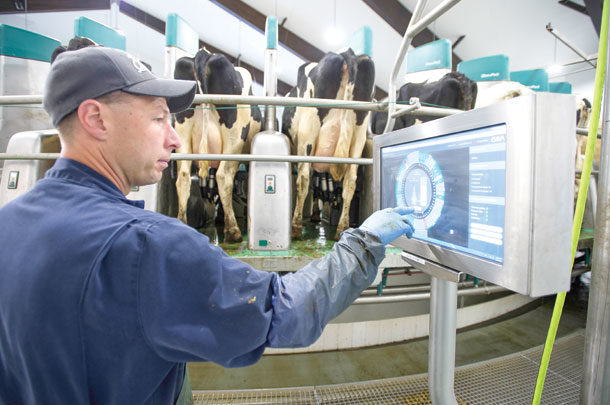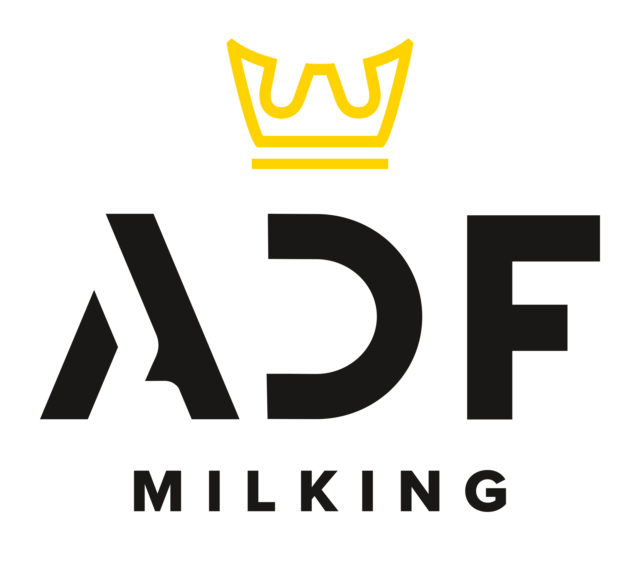He farms with his two brothers-in-law, Richard and Michael Tenbrinke, on the Chilliwack, British Columbia, farm started by their father, Wally Tenbrinke, and his brothers in the 1970s.
Once the farm size reached several hundred cows, it became apparent something needed to be done differently. “As we were thinking of getting bigger, the old parlour was taking too long for one man to milk, especially if it’s a manager. I didn’t want to spend eight or nine hours a day milking 1,000 cows,” John says.
They discussed switching to a rotary parlour from their double-16 herringbone, but they didn’t like the idea of having three to four people positioned around the parlour for every milking. When they heard of the possibility of an automatic rotary parlour, they traveled to Germany in March 2015 to see it in operation.
“It was almost a no-brainer after that,” John says. “We just had to make the financing work.” Later that year, they broke ground on a new facility for the parlour and two new flush barns. By the following March, Gracemar Farms was the first farm in North America to milk cows in this new robotic 60-stall rotary parlour.
“This way, we can move to a faster parlour and still have the efficiency of one man managing it,” John says. At 300 to 350 cows per hour, John now milks 1,050 cows and sprays down the parlour in just five hours.
“It’s basically a no-man parlour, but you should still have a parlour manager that knows what he’s doing. They can’t just be a kid,” he says.
For the most part, his role in the parlour is to monitor its performance. There’s a touch screen with a picture of the rotary that alerts him to cows that may require attention. If a machine slips off, he can look at the cow on the screen and her data to see if she needs reattachment or not.
There are two groups that require a bit more attention from the operator. The first group is their non-conforming cows, which have difficulties with attachment due to teat placement. John does a lot of walking and manually attaching in that group.
Then the last group milked each shift is the fresh cows from zero to three days fresh. “They are skittish and are manually attached until they are used to the parlour,” he says. John likes that he can still be there for every morning milking without the shift being as strenuous as it was before.
“I’ve been around the cows for the morning. I can look at the reports. It’s all done in smaller time frame and still with the efficiency of only one man actually running the parlour. It’s not stressful. I’m not actually hanging machines,” he says.
The biggest savings came from adding cows without adding labour. They run two different farms. The second farm used to have six people milking a 300-cow herd three times a day plus caring for all of the youngstock.
With the addition of the new parlour and two big barns, John moved half of that milking herd to the main farm and now only has one person there milking 150 cows twice a day. “I can milk more cows with the same amount of people,” he says. “I haven’t hired anybody else. I just maneuvered everybody’s shift.”
Previously, it took six hours to milk 650 cows. Now, they can milk 1,050 cows in 4.5 hours with spraydown. That person is now free to do other tasks, such as cleaning up the parlour, pressure washing or tractor work because their shift isn’t full with just milking.
In addition to someone in the parlour, the farm has a cow handler to usher cows to the parlour. John says their groups are relatively small at 150 cows per group, so every half-hour another group is ready to load.
“Once he starts getting cows, he won’t stop walking until he chases the last group out. Then he has another four hours of his shift that I can still use him for stuff,” John says. Milking time has also increased from enhanced udder preparation by the automatic milking units.
In the old parlour, they operated as a no-prep facility to keep the labour down to one man per shift. In that system, the average milking time was 4.9 minutes per cow. Now, each stall is equipped with a robotic module that automatically stimulates, cleans, dries and forestrips right inside the teat cup.
It also post-dips and allows for individual quarter detachment. By prepping the cow, they have eliminated the secondary letdown that would cost them 30 to 45 seconds in the old parlour when the cow would milk nothing because she hadn’t reached the oxytocin stage.
In the new parlour, they are now averaging 3.8 minutes of milking time per cow. “I didn’t think I would gain a whole minute and still the same milk production,” John says. “That was a big benefit. We can turn the wheel a little faster, and the cows milk out better.”
Another way they are keeping the wheel turning is by grouping the non-conforming cows together. When they first started, they had five groups of cows with the non-conforming cows spread throughout each group.
“Every four to five cows, we had to attach one manually. There was not really a time you could actually sit back and watch the robots work. You were always interfering,” he says.
A lot of these cows were pregnant and producing a lot of milk, so he wasn’t interested in getting rid of them. Instead, they put them into a single group, regardless of stage of lactation, and fed a mid-lactation ration.
The parlour generates a report on cows requiring manual attachment, so John reviews that every few weeks to move cows into the non-conforming group. He says he hopes to eventually wean all of those cows out through breeding robot-ready cows.
Roughly every two out of three cows in that group have crossed teats, very close teats or narrow teats and require a manual attachment. He says it takes about 20 to 30 minutes to work through that group, then the rest of the milking shift he can just watch the robot at work.
That is, until the fresh cow group comes in at the end. Since they are a little skittish, especially the 2-year-olds, John prefers to manually attach this group so they get used to the feeling of the milking machine before they experience the feeling of the robot arm wiggling between their legs.
There was a portion of the herd that was unable to adjust to the new system. For the most part, they were older cows that didn’t like the confined space, he says, noting they ended up culling 6.5 to 7.5 percent from this farm and moved them to his brother-in-law’s parallel parlour.
“We were ready to lose some cows, but I didn’t lose them for the fact that they had to go for meat. I just lost them from this dairy,” he says.
Looking back at the start-up of the parlour, John says he would recommend a gradual introduction to anyone else using this system. They ended up putting the cows on right away, trying to get the robot to learn what to do.
Instead, he would have rather introduced the cows to the new parlour after being milked in the existing parlour. He’d let them run on there empty so they could get used to it.
Then three milkings later, he would use the new parlour for milking but put all of the machines on manually, similar to how he introduces his 2-year-olds. After a couple of milkings, he would turn on the parlour’s automatic attachment.
“We kind of just jumped in and let the robot do all of the work and put them on when they were full of milk. I probably wouldn’t do that again,” John says. “If I were to do it again myself, I would gradually do that entry.”
In addition to the new robotic rotary parlour, the farm installed a flush system in the new barns for ease of operation in cleaning. The barns are sand-bedded freestalls with alleys flushed three times a day when the cows are being milked.
“We flush every time the cows are in the parlour milking, which is kind of another reason to look at an automatic rotary rather than box-stall robots because the cows would have to be in the group all day,” John says. “The way our barn flushes won’t allow that. There’s too much of a ridge of water [that would splash the cows].”
The barns are set at 3 and 4 percent slope because of the sand bedding. After leaving the barns, the flush travels down a 110-foot settling lane where the farm reclaims 92 percent of the sand for reuse as bedding.
After exiting the sand lane, the flush from the barn enters a separator and then a roll press. Solids are stacked and spread on cropland between crops. The liquids are stored in an upright storage container where gravity settles the fine solids to the bottom.
“We flush off the top so we have the cleanest water for flushing,” John says. This helps reduce odour and produce cleaner sand. It also provides consistency of flush water, compared to only pumping from a lagoon, which can fluctuate based on the time of year and how much liquid it is holding.
Finding ways to automate tasks around the farm has helped the owners of Gracemar Farms grow the farm without removing them from their active daily responsibilities. ![]()
PHOTO: John Kampman monitors the 60-stall automatic rotary parlour from a touch screen in the parlour. Photo courtesy of GEA Farm Technologies.

-
Karen Lee
- Editor
- Progressive Dairyman
- Email Karen Lee









